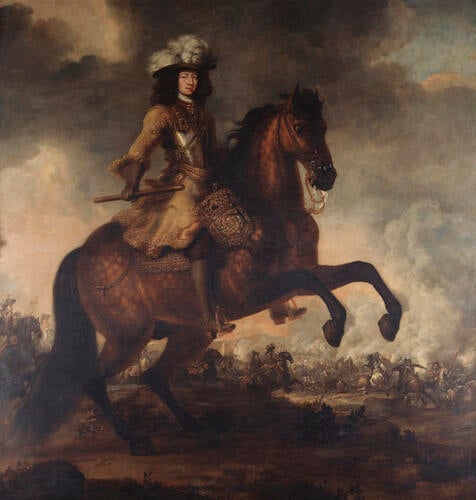-
1 of 253523 objects
Charles XI, King of Sweden (1655-1697) c. 1680
Oil on canvas | 295.5 x 278.8 cm (support, canvas/panel/stretcher external) | RCIN 405909
-
Charles XI succeeded his father, Charles X, in 1660 and reigned as King of Sweden from 1672 (when he reached the majority age of 17) until his death in 1697. During the Scanian War in the 1670s he led the country in battles against Denmark and Brandenburg, with peace treaties finally reached in 1679. In these wars he acted as an ally of the French King, Louis XIV; this meant that he belonged to the same broad alliance as Louis XIV’s first cousins, Charles II and James II of England. He was made a member of the Order of the Garter in 1668 and two equestrian portraits of him were apparently acquired during this period (1660-88). After the Glorious Revolution, William III’s hostility to France would have made the acquisition of a portrait of a French ally less likely. A portrait of the ‘King of Sweden on horseback, big as the life’ is recorded in the Square Table Room at Whitehall in 1688, which might be this one. There are two equestrian portraits consistently recorded throughout the 18th century, one slightly smaller than this one at Kensington Palace (listed in 1710, 1790 and 1818 and now lost) and this one at Windsor Castle (listed, measured and illustrated).
The Italian diplomat, Lorenzo Magalotti, who visited the Swedish court in 1674, gives an illuminating character study of the young monarch: 'King Charles, the eleventh of that name, has the appearance of a man who is embarrassed and afraid of everything. It seems as though he did not dare look anyone in the face, and he moves as though he were walking on glass. On horseback he has the appearance of quite a different person, looking every inch a king. Then he looked untroubled and at ease, he is lively and free of the compulsion which hovers about him indoors'.
The King's elegant attire consists of a gold-embroidered elkskin buff coat, a polished steel breastplate and richly plumed hat. He carries a baton of command and around his neck is the badge of the Order of the Garter. The Swedish regiment of the Royal Horse Guards (Livregementet till Häst) were issued with elk-hide jerkins in 1673, and in 1680 the King commanded that they be knee-length. In 1695 official dress for the Horse Guards was changed to a blue coat, with the jerkin worn beneath. The dappled chestnut horse wears a heavily embroidered and fringed blanket decorated with the crowned cipher of Charles XI and jewelled stirrups.
David Klöcker was born in Hamburg and trained in Amsterdam. In 1652 he was taken up by a Swedish nobleman, Carl Gustav Wrangel (1613-76); he toured Italy, France and England from 1654; upon his return to Sweden in 1661 he was made court painter; in 1674 he was ennobled and added the name Ehrenstrahl to his birth name. He painted a number of equestrian portraits of the king, the majority of which depict him at the snowy Battle of Lund in the winter of 1676. This example is unusual in showing him against a summer-green battlefield and probably depicts the King during either the battle of Halmstad in August 1676, or the battle of Landskrona in July 1677. It has been suggested that the background cavalry scene was painted by Jan Wyck (1652-1702), a Dutch artist who regularly collaborated with other portraitists including Sir Godfrey Kneller and William Wissing. This is believed to be the original portrait from which a number of versions were made.Provenance
Possibly the painting recorded in the Square Table Room at Whitehall Palace in 1688; subsequently hanging in the King's Guard Chamber at Windsor Castle from 1710 until 1819, when it appears in Pyne's Royal Residences (RCIN 922111).
-
Creator(s)
-
Medium and techniques
Oil on canvas
Measurements
295.5 x 278.8 cm (support, canvas/panel/stretcher external)
337.3 x 321.0 x 17.4 cm (frame, external)
Category
Object type(s)
Subject(s)
